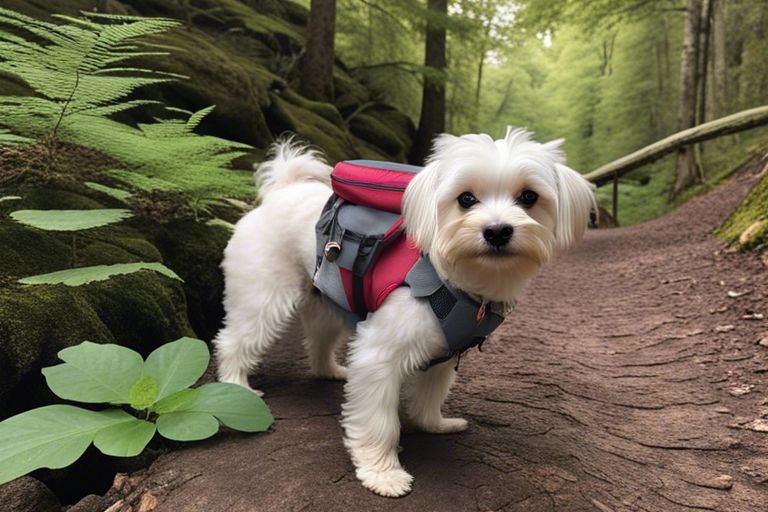Unquestionably, the answer is a resounding yes! As an avid hiker and devoted dog owner, I can attest to the fact that small dogs are more than capable of joining you on your outdoor excursions. While it is important to consider your dog’s breed and physical capabilities, many small breeds such as Chihuahuas, Dachshunds, and Jack Russell Terriers are energetic and adventurous enough to tackle long walks and even hikes. However, it is crucial to be mindful of their weight, age, and health before embarking on any strenuous activities. It is also imperative to be prepared with proper gear such as a fitted harness, collapsible water bowl, and first-aid kit in case of any unforeseen circumstances. With the right precautions and training, small dogs can make wonderful companions on outdoor adventures.
Key Takeaways:
- Small dogs can go on hikes or long walks with proper training and conditioning. It’s important to gradually increase the distance and difficulty of the walks to ensure the dog can handle the physical activity.
- Consider the breed and physical condition of the small dog before taking them on hikes or long walks. Some small breeds are better suited for these activities than others, and older dogs or those with health issues may not be able to handle extensive physical exertion.
- Provide proper gear and care for small dogs when taking them on hikes or long walks, including a well-fitted harness, ample water, and breaks to rest and cool down. It’s important to be mindful of the dog’s comfort and safety throughout the activity.
Understanding Small Dogs
If you’ve ever wondered if your small dog can join you on a hike or long walk, you’re not alone. Many small dog owners wonder about their pet’s ability to handle outdoor activities. In this blog post, I want to address the concerns and considerations of taking small dogs on hikes and long walks. It’s important to understand their limitations and capabilities to ensure their safety and well-being. Before you hit the trails with your small dog, it’s essential to have a good understanding of what to expect.
Breed Characteristics
Small dogs come in all shapes and sizes, each with their own unique breed characteristics. While some small dog breeds are known for their high energy levels and endurance, others may have physical limitations that affect their ability to go on long hikes. It’s important to research your specific breed to understand their natural instincts and capabilities. For example, some small dog breeds, such as Jack Russell Terriers and Chihuahuas, are known for their high energy levels and are usually more capable of handling long walks or hikes. On the other hand, brachycephalic breeds, such as Bulldogs and Pugs, may struggle with intense physical activity due to their shortened airways, which can lead to breathing difficulties. Understanding your small dog’s breed characteristics will help you determine their ability to handle outdoor activities.
Physical Limitations and Stamina
Despite their size, small dogs can surprise you with their stamina and endurance. However, it’s essential to be mindful of their physical limitations. Small dogs have a higher metabolism and may tire more quickly than larger breeds. It’s crucial to monitor their behavior and breathing during outdoor activities. Additionally, some small dogs may be prone to overheating due to their small size and lack of insulation. It’s important to ensure they have access to shade and water to prevent heat exhaustion. Keep in mind that certain terrains, such as steep inclines or rough terrain, can be challenging for small dogs to navigate. It’s important to be mindful of their physical limitations and adjust your hiking or walking pace accordingly.
By understanding your small dog’s breed characteristics and physical limitations, you can make informed decisions about whether they can join you on hikes or long walks. It’s essential to prioritize their safety and well-being while also considering the positive experiences that outdoor activities can provide for both you and your small dog. If you want to learn more about hiking with a small dog, you can check out my article Hiking With A Small Dog: Tips to Know Before You Go for more valuable insights.
Preparing for Outdoor Adventures
Obviously, before taking your small dog on a hike or long walk, it is important to make sure you and your furry companion are adequately prepared for the outdoor adventure. This includes considering your dog’s health and fitness, as well as ensuring you have the essential gear and supplies to keep both of you safe and comfortable.
Health and Fitness Considerations
When it comes to taking small dogs on hikes or long walks, it’s important to consider their health and fitness levels. While small dogs are generally active and energetic, it’s crucial to assess whether your dog is physically able to handle the rigors of outdoor excursions. It’s recommended to consult with your veterinarian to ensure your dog is in good health and physically capable of the activity. Additionally, it’s essential to monitor your dog’s stamina, especially if they are not used to extended periods of physical activity. Be mindful of overexertion, dehydration, and potential injuries along the way.
Essential Gear and Supplies
Before embarking on an outdoor adventure with your small dog, make sure you have the essential gear and supplies to ensure both of your safety and comfort. This includes a well-fitted harness or collar with identification tags, a sturdy leash, and a pack for your dog to carry some of their own supplies. Additionally, bring plenty of water and a collapsible bowl for your dog to drink from, as well as some food and treats for energy. It’s also crucial to pack a first aid kit for your dog, including items such as bandages, antiseptic wipes, and any necessary medications. Lastly, be sure to pack waste bags to clean up after your dog along the trail.
I hope this information helps you prepare for your outdoor adventures with your small dog. Happy hiking!
Safety and Comfort on the Trail
Keep your small dog safe and comfortable while hiking by ensuring they have the right gear and are in good physical condition. Your dog should wear a properly fitted harness, and you should always carry a first aid kit and plenty of water for both of you. It’s important to pay attention to your dog’s behavior and make adjustments as needed to keep them safe and happy on the trail.
Navigating Terrain and Distance
When taking your small dog on hikes or long walks, it’s important to consider the terrain and distance of the trail. While small dogs can handle moderate terrain and shorter distances, it’s crucial to be mindful of their endurance. Remember that small breeds may have to take more frequent breaks and may be more susceptible to fatigue. It’s important to keep a close eye on their behavior and adjust your pace accordingly to ensure they aren’t overexerted.
Recognizing and Responding to Distress Signs
Small dogs may not be able to communicate distress as clearly as larger breeds, so it’s crucial to be familiar with the signs that indicate they may be in distress. Watch for excessive panting, limping, or lagging behind, which could indicate fatigue or discomfort. If you notice any of these signs, it’s important to stop and rest, offer water, and assess the situation. Additionally, keep an eye out for potential hazards such as hot pavement, sharp rocks, or steep inclines that could pose a danger to your small dog. Stay alert and be prepared to take immediate action to ensure their well-being.

Enhancing the Hiking Experience
Not all hikes are created equal, and there are several ways to enhance the hiking experience for your small dog. Here are some tips to help make your outdoor adventures with your four-legged friend even more enjoyable.
Training and Conditioning Tips
When preparing for a hike with your small dog, it’s important to make sure they are in good physical condition. Start by gradually increasing the length and intensity of your walks to build up their endurance. Engage in regular exercise and activities such as running, swimming, or playing fetch to improve their overall fitness level. Additionally, it’s crucial to train your dog to walk on a leash and respond to basic commands, such as “sit” and “stay,” to ensure they are under control during the hike.
- Regular exercise: Engage in daily activities to improve your dog’s fitness level.
- Leash training: Teach your dog to walk obediently on a leash.
- Basic commands: Ensure your dog responds to crucial commands for their safety.
The key is to build up their endurance gradually, making sure they are physically capable before embarking on any long hikes. The last thing you want is for your small dog to become overwhelmed or exhausted on the trail.
Finding Suitable Trails for Small Dogs
When choosing a trail for hiking with your small dog, it’s essential to consider their physical limitations and specific needs. Look for trails that are relatively flat and not too steep, as steep inclines can be challenging for small dogs. Avoid trails with rough terrain or obstacles that could be difficult for your dog to navigate. Additionally, research the trail to ensure it has plenty of shade and water sources along the way, especially on hot days. Finding a dog-friendly trail will make the experience more enjoyable for both you and your furry companion.
Can small dogs go on hikes or long walks?
Conclusively, small dogs can absolutely go on hikes and long walks, as long as you take their physical limitations and endurance into consideration. It’s important to assess your dog’s fitness level and start with short, easier hikes before gradually increasing the distance and difficulty. It’s also crucial to bring plenty of water, snacks, and a first-aid kit for your furry friend. With proper preparation and training, small dogs can enjoy the great outdoors just as much as their larger counterparts. Remember to always consult your veterinarian before starting any new exercise regimen with your pet.
Can Small Dogs Go on Hikes or Long Walks? – FAQ
Q: Are small dogs physically capable of going on hikes or long walks?
A: Yes, many small dog breeds are physically capable of going on hikes or long walks. However, it’s important to take into consideration their breed, age, and overall health before planning any strenuous activities. Small dogs with short legs or health issues may not be suitable for long hikes, while more active breeds may thrive on outdoor adventures. It’s important to consult with a veterinarian to ensure your small dog is ready for this kind of physical activity.
Q: What should I consider before taking my small dog on a hike or long walk?
A: Before taking your small dog on a hike or long walk, consider their fitness level, any health issues, and the weather conditions. It’s important to start slow and gradually increase the length and intensity of the walks to build up their endurance. Additionally, small dogs may not tolerate extreme temperatures as well as larger breeds, so be mindful of the weather and bring plenty of water and rest breaks for your furry friend.
Q: Are there any safety precautions I should take when hiking with a small dog?
A: When hiking with a small dog, it’s important to keep them on a leash at all times to ensure their safety. Small dogs can easily become prey to larger animals or get lost in unfamiliar territories. Additionally, be mindful of the terrain and watch out for any potential hazards such as steep cliffs or rough terrain that could pose a risk to your small dog. It’s also a good idea to pack some basic first aid supplies for your dog in case of any minor injuries while on the trail.


